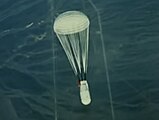| Test No. 6 | |
|---|---|
 Test No.6, 3.3 megatons. Test No.6, 3.3 megatons. | |
| Information | |
| Country | China |
| Test site | Lop Nur Test Base |
| Period | June 17, 1967 |
| Number of tests | 1 |
| Test type | Atmospheric |
| Device type | Fusion |
| Max. yield | 3.3 megatons of TNT (14 PJ) |
| Test chronology | |
| ← 59616th test → | |
Test No. 6 is the codename for China's first test of a three-staged thermonuclear device and, also its sixth nuclear weapons test. It was a part of the "Two Bombs, One Satellite" program.
Development
The device was detonated at Lop Nur Test Base, or often dubbed as Lop Nur Nuclear Weapon Test Base, in Malan, Xinjiang, on 17 June 1967. With successful testing of this three-stage thermonuclear device, China became the fourth country to have successfully developed a thermonuclear weapon after the United States, Soviet Union and the United Kingdom. It was dropped from a Xian H-6 (Chinese manufactured Tu-16) of the 36th Air Division and was parachute-retarded for an airburst at 2960 meters. The bomb was a three-stage device with a boosted U-235 primary and U-238 pusher. The yield was 3.3 megatons.
The film of the prior 1966 tests have been released, as well as an unidentified later test.
It was a fully functional, full-scale, three-stage hydrogen bomb, tested just 32 months after China had made its first fission device. It remains to date the fastest of any country to successfully develop this capability.
China had received extensive technical help from the Soviet Union to jump-start their nuclear program, but by 1960, the rift between the Soviet Union and China had become so great that the Soviet Union ceased all assistance to China and refused to help the Chinese government with their nuclear program.
The goal of China was to produce a thermonuclear device of at least a megaton in yield that could be dropped by an aircraft or carried by a ballistic missile. Several explosions to test thermonuclear weapon designs, characteristics and yield boosting preceded the thermonuclear test.
Gallery
See also
- Two Bombs, One Satellite
- 816 Nuclear Military Plant
- List of Chinese nuclear tests
- List of states with nuclear weapons
- Teller–Ulam design
References
Citations
- Zhang, Hui (2024-04-11). "The short march to China's hydrogen bomb". Bulletin of the Atomic Scientists. Archived from the original on 2024-04-11. Retrieved 2024-04-15.
- Allen, Kenneth W. (2 May 2022). "PLA Air Force Bomber Force Organization" (PDF). China Aerospace Studies Institute. Air University, Montgomery, Alabama. Archived (PDF) from the original on 2022-11-18. Retrieved 2024-04-15.
- wolfkinler (2013-04-08), 中国的核试验1966, archived from the original on 2021-12-21, retrieved 2018-01-24
- ^ "China's Nuclear Weapon Development, Modernization and Testing". Nuclear Threat Initiative. September 26, 2003. Archived from the original on October 8, 2011. Retrieved November 4, 2011.
Sources
- Books
- Norris, Robert, Burrows, Andrew, Fieldhouse, Richard. Nuclear Weapons Databook, Volume V, British, French and Chinese Nuclear Weapons. San Francisco, CA: Westview Press, 1994. ISBN 0-8133-1612-X.


